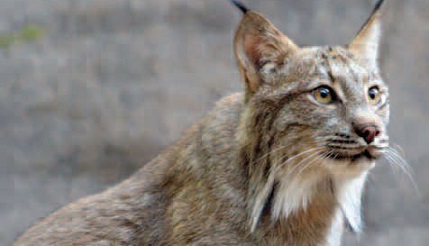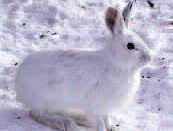SCORES & OUTDOORS: Canada lynx surviving in Maine
 by Roland D. Hallee
by Roland D. Hallee
Recently, two Canada lynx were found dead in northern Maine, spawning an investigation into why, and who, killed the predatory cat.
The Canada lynx, Lynx canadensis, was listed as threatened on March 24, 2004, by the U.S. Department of Fish and Wildlife.
Canada lynx are medium-sized cats, generally 30-35 inches long and weighing 18-23 pounds. They have large feet adapted to walking on snow, long legs, tufts on the ears, and black-tipped tails. They are highly adapted for hunting snowshoe hare, the primary prey, in the snows of the boreal forest.

A Canada lynx in the wild.
Lynx in the contiguous United States are at the southern margins of a widely-distributed range across Canada and Alaska. The center of the North American range is in north-central Canada. Lynx are found in coniferous forests that have cold, snowy winters and provide a prey base of snowshoe hare. Lynx, primarily found in northern Maine, prey almost exclusively on snowshoe hare, so the fate of both species are linked.
Lynx can only flourish in a large boreal forest that contains appropriate forest types, snow depths and high snowshoe hare densities. In the Northeast, lynx were most likely to be in areas that support deep snow (106 inches annually), associated with regenerating boreal forest landscapes.
Lynx are highly mobile and have a propensity to travel long distances, particularly when prey becomes scarce.
Some believe both lynx and coyotes would compete for the same food, but during a recent 12-year study, it was found that is not the case. Lynx roam the deep snow without problems, while coyotes travel more in packs along trails and road systems, and are more likely to attack larger prey, such as deer.

A snowshoe hare, the favorite prey of the lynx, with its winter coat.
The historic and current range of the lynx in the contiguous United States is within the southern extensions of the forests of the Northeast, Great Lakes, Rocky Mountains and Cascade Mountains.
The lynx is listed in 14 states that support the environment needed to sustain the animal. Maine, New Hampshire and Vermont are three of them.
The environment in Maine is perfect to support Canada lynx populations. Harsh winters, deep snow, dense evergreen forests and sub-zero temperatures are exactly what the lynx likes. But, due to extensive hunting for its pelts in the 1960s, the cat nearly disappeared from Maine. Only a new law enacted in 1967, has protected it from hunting and trapping.
According to Jennifer Vashon, in charge of Maine Department of Inland Fisheries and Wildlife lynx program, it is believed the lynx population in Maine is at a historic high. More than 1,000 adult lynx are believed to be inhabiting the Maine forests. Even though it doesn’t sound like very many, compared to other fur bearing animals in the state, the lynx is actually living at the edge of its range.
Recently, a friend of mine who keeps farm animals in Richmond, reported sighting a lynx that was checking out his chicken coop.
Although the lynx was placed on the federal threatened species list, it is only listed as a species of special concern in the state of Maine.
Legal trapping, snaring, and hunting for bobcat, coyote, wolverine, and other fur-bearers create a potential for incidental capture of lynx. Lynx persist throughout their range despite the incidental catch that presumably has occurred throughout the past, probably at higher levels than presently.
Even though the animal rights group won a ruling about the state taking steps to prevent the occasional accidental trappings, they were not successful in their request for temporary suspension of some trapping where lynx are present in northern Maine.
Subsequently, inadvertent trappings of Canada lynx occur from time to time.
Responsible journalism is hard work!
It is also expensive!
If you enjoy reading The Town Line and the good news we bring you each week, would you consider a donation to help us continue the work we’re doing?
The Town Line is a 501(c)(3) nonprofit private foundation, and all donations are tax deductible under the Internal Revenue Service code.
To help, please visit our online donation page or mail a check payable to The Town Line, PO Box 89, South China, ME 04358. Your contribution is appreciated!


Leave a Reply
Want to join the discussion?Feel free to contribute!